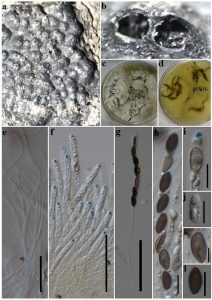Nemania bipapillata (Berk. & M.A. Curtis) Pouzar, Česká Mykol. 39: 24 (1985)
Index Fungorum number: IF106291, Facesoffungi number: FoF 09082
Saprobic on a decaying twig. Sexual morph: Stromata superficial, aggregated, brown crustose on wood, laterally and apically very thick except for the ostiolar region. Ascomata perithecial, immersed in stroma, subglobose, carbonaceous, raised in the central region with ostioles, flat apex with central brown papilla. Peridium black to brown cells of textura angularis, inner hyaline, and textura angularis cell layers. Paraphyses filamentous, septate, unbranched, within the asomatal content. Asci 120–176 × 6.8–8.4 μm (x̅ = 149.9 × 7.4, n = 25), unitunicate, 8-spored, cylindrical, apically rounded with J+ apical ring, cylindrical (1.8)1.9–2.6 × 1.8 – 2.1 μm (x̅ = 2.3 × 2.0 n = 25) long pedicellate. Ascospores (10.6) 11.5–15.6 (16.0) × (4.7) 5.5–7.6 (8.2) μm (x̅ = 12.5 × 6.3, n = 25), aseptate, overlapping uniseriate, broad, ovoid, hyaline when young, becoming brown to dark brown when mature, slightly curved germslit, apically slightly wider than basal ends, obtuse apices, smooth-walled with a single guttule. Asexual morph: Undetermined.
Material examined – India, Andaman and Nicobar Islands, South Andaman, Mount Harriet, Gun Point (11˚72’23”N 92˚73’80”E), decaying twig, on 7 December 2017, collected by M. Niranjan & V.V. Sarma (AMH-10074, Ajrekar Mycological Herbarium, India), living culture PUFNI 17612; India, South Andaman, Jirkatang (11˚45’5” N 92˚39’7”E), terrestrial forest, on an unidentified decaying twig, 28 March 2017, collected by M. Niranjan & V.V. Sarma (PUFNI T128F1, Pondicherry University in-house herbarium).
GenBank accession number – LSU: MK994102.
Known distribution (based on molecular data) – Brazil, Cameroon, China, Ecuador, Germany, India, Malaysia, Mauritius, Philippines, Reunion, Thailand, Taiwan, USA(https://www.ncbi.nlm.nih.gov/nuccore).
Known hosts (based on molecular data) – Acalypha diversifolia, Asparagopsis taxiformis, Camellia sinensis, Cinnamomum sp., Dendrobium heterocarpum, Dendrobium longicornu, Diospyros crassiflora, Faramea aff. Oblongifolia, Vaccinium dunalianum, Vanilla planifolia, Jatropha sp., Usnea sp., Lichen Usnea (https://www.ncbi.nlm.nih.gov/nuccore, Ju & Rogers 2002).
Notes – Morphological characters and sequence analysis results show that our taxon is Nemania bipapillata which corroborates the morphological description and provides a key to the species of Nemania provided by Smith & Hyde (2001). Our collection has similar morphological features, such as erumpent stromata that are hemispherical, dark brown, and have one to many ascomata. The asci of our specimen are longer and slightly wider, and the ascospores are wider than the type (Smith & Hyde 2001). The recent collection of Nemania bipapillata from the French West Indies (Fournier et al. 2018) has ellipsoid to elongated stromata comprising outer carbonaceous and inner white loosely arranged fibrous tissue at margins, whereas in our collection these differences were not found. Further, the ascospores of our taxon are slightly larger than the ones reported from the French West Indies (Fournier et al. 2018). However, the subglobose to depressed-spherical perithecia are similar to this collection.

Fig. 1 – Nemania bipapillata (PUFNI 17612). a Stromata on host. b Stromata vertical section. c, d Culture on MEA plates. e Paraphyses. f–h Asci. i J+ apical ring. j–l Ascospores. Scale bars: f, g = 50 μm e = 20 μm, h–l = 10 μm.
